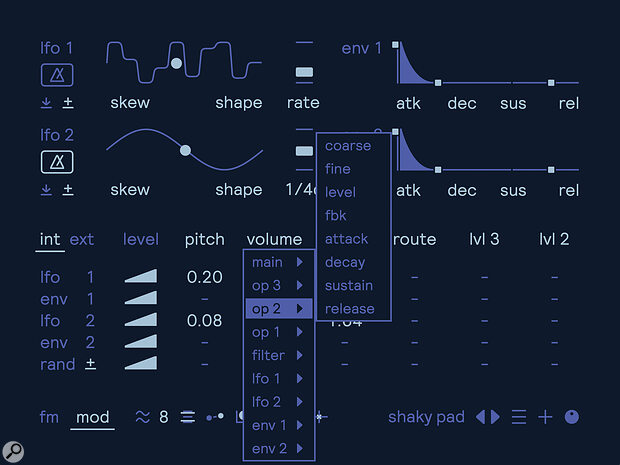The user interface has always been a barrier to FM synthesis. Can Fors’ elegant approach make it more accessible?
Over the last few years I’ve been seeing an increase in software bloat in audio plug‑ins, whether that’s the hundreds of presets, 3D animated graphics or just the complexity of hybrid synthesis models with long chains of built‑in effects. It’s therefore a relief to come across something as simple, clean and focused as Pivot by the Sweden‑based company Fors. Pivot brings Scandinavian minimalism to classic FM synthesis (or, to be pedantic, phase modulation), with a clean design aesthetic, all simple geometric forms and lower‑case labels. Its resizeable window flips between a panel for synthesis and one for modulation. The plug‑in is compatible with macOS, Windows and Linux, and supports the modern CLAP standard as well as VST3 and AU.
Pivot Point
The style of FM on offer here is pretty simple: three operators (one carrier plus two modulators) and two algorithms. In fact, Fors are emphatic that Pivot is algorithm‑free, and that’s true in the sense that you can smoothly morph between two operator layouts, so algorithm selection is not either/or. There’s also a multi‑mode filter (comb, acid or SVF, the latter being able to shift continuously between low‑pass and high‑pass) and a smattering of simple effects.
The two extremes of the operator configuration value (called ‘route’) are a 3‑op stack, and a two‑modulators‑into‑one‑carrier tree. The route value ‘pans’ the third operator’s output between the first and the second. This seems to cover all the important tonal ground, although you’re limited to a single carrier throughout. An iconic three‑dice logo shows the routing mix. Operators 2 and 3 have the usual pitch controls (course and fine), although the carrier has none, so there’s no overall transpose. All three operators have their own ADSR envelope, as does the filter, and operators 2 and 3 have a level setting and feedback loop (to themselves only). The interface is pretty much devoid of knobs and sliders: you can drag control points to shape the envelopes, but the level, feedback and filter envelope follow controls look more like road signs than synthesizer knobs, although dragging up or down on them works as expected, with visual feedback.
The one concession to rich visual display is waveforms, showing the signals that are flowing between the operators and also the final pre‑effects audio output. I hooked up a software oscilloscope to the plug‑in and can confirm, should you be concerned, that this display is accurate.
Pivot’s effects section is pretty minimal: there’s a very gentle chorus for providing some stereo width (‘width’ being its only parameter), an effect like a bit‑crusher, and a distortion effect, which I found a little underwhelming. Pivot’s raw sound is pretty dry, so you’ll have to rely on your DAW’s suite of effects to add warmth and richness. There is a unison mode which runs three voices for each note, and they can be detuned as far apart as two octaves, if you want to layer up and fill up the frequency spectrum a bit.
Flip to Pivot’s modulation panel and you’ll find a pair of LFOs, with a selection of shapes, and a continuous skew parameter to reshape or provide PWM. Rates can be Hertz or tempo‑time, and output can be uni‑ or bipolar. The LFOs are per‑voice, can reset on key‑down or be beat‑sync’ed, but there’s no phase control. There are two additional ADSR envelopes available as modulation sources as well.
You can modulate from up to five internal sources (LFOs, envelopes, a note‑on random generator) and five external MIDI ones (pitch, velocity, mod wheel, pressure, MPE front‑back slide). MPE left‑right glide tracks pitch as expected (it’s not available as a modulation source), although old‑school pitch‑bend is hard‑wired to a two‑semitone range. The full modulation limits for pitch are pretty extreme at ±96 semitones, which is pretty much Nyquist to DC, so you’ll need to keep that in check.
In a world of ultraprocessed software instruments, it’s good to come across something this pure and refreshing.
May The Fors Be With You
If you’re used to more sophisticated instruments, Pivot might seem a bit weak — a dry sound, relatively simple FM implementation — but on a recent project I found myself using it a lot. It’s clear both conceptually and visually, does most of the harmonically rich and animated FM that you could want, and is very approachable. My review copy came with very few presets, but I don’t think I used any of them, instead just grabbing the on‑screen controls to make sounds from scratch each time. In a world of ultraprocessed software instruments, it’s good to come across something this pure and refreshing.
Summary
Pivot is an elegant and approachable 3‑op FM synth with morphable algorithm and filter, dedicated modulation matrix and MPE support in a sleek designer package.


